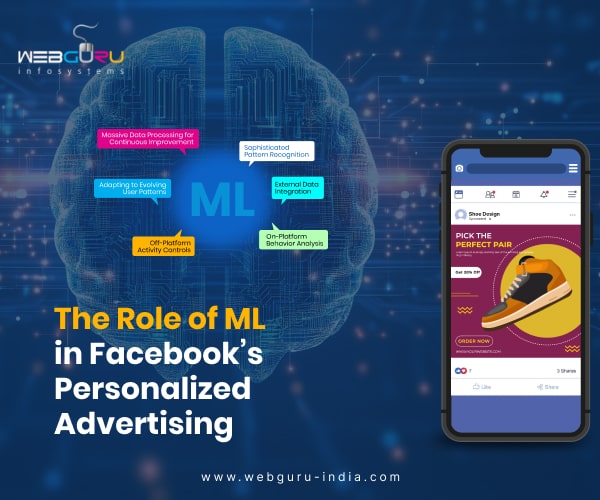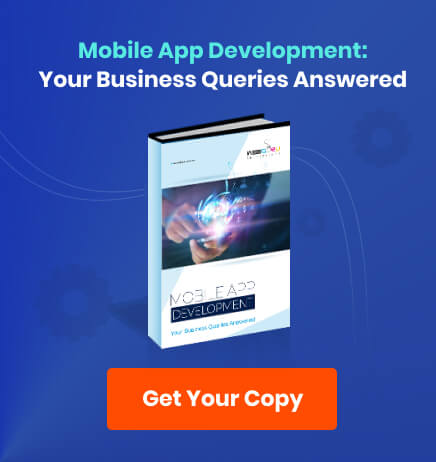Home Blog Digital Marketing Services How Facebook Uses Machine Learning to Power Personalized Ads
How Facebook Uses Machine Learning to Power Personalized Ads
- 23 Jun / 2025
- 1,632 views
- 8 Min Read

Facebook utilizes advanced machine learning to deliver highly personalized ads. It analyzes user behavior, preferences, and interactions both on and off platforms. Its smart algorithms calculate estimated action rates and ad quality scores and then decide which ads to show. Facebook advertising aims for maximum relevance and engagement. This is one of the best ways to reach the right audience while enhancing user experience. Businesses that can’t navigate these intricacies can take the help of a reliable social media marketing agency to optimize campaigns and drive better results through targeted ad strategies.
Ever noticed how the ads that appear on the Facebook feed feel almost too relevant? You may have looked at hiking boots or a cosmetic product, and minutes later, an ad pops up offering discounts on the exact brand you searched for! It’s not a coincidence—it’s machine learning doing its magic.
For brands working with a social media marketing agency like Webguru Infosystems, this hyper-personalization brings them more engagement, better leads, and smart budget spending.
But how does Facebook pull this off, actually? Let us help you understand the tech behind those eerily accurate ads and the mutual benefits for both users and businesses.
How Facebook’s Advanced Auction System Works with Machine Learning
Facebook’s advertising engine uses a sophisticated auction process that extends far beyond conventional bidding wars. Let’s take a deeper look at how the auction system works with ML.
a. Lightning-Fast Micro-Auctions
Every time someone visits Facebook or Instagram, the platform runs thousands of micro-auctions in milliseconds. Before determining which advertising should take up valuable screen space, the algorithm considers a plethora of factors. These lightning-fast decisions are made behind the scenes as consumers navigate through their feeds.
b. Audience Selection and Targeting Tools
First, advertisers use Facebook’s self-service tools to choose their target audience. These audiences may consist of demographics such as location and age. Additionally, they can include behavioral data like past ad interactions and page likes. Businesses can upload email lists or directly target website visitors with custom audiences. Brands can locate new customers who are similar to their current clientele by using lookalike audiences.
c. Quality Over Bidding Power
Based on targeted parameters, the platform then compiles all relevant advertisements for the user. Facebook’s algorithms determine the winners when these ads get to the auction stage. Facebook gives equal importance to ad quality and relevancy, so the highest bidder does not always win. This strategy ensures that viewers see good information instead of just pricey advertisements.
d. On-Platform Behavior Analysis
Facebook’s machine learning models examine user activity trends across several touchpoints at once. The system monitors what users do within the Facebook app family. These include interacting with business pages, sharing posts, and clicking on advertisements. Targeting insights can also be obtained through friend connections and profile updates.
e. External Data Integration
The platform also considers off-platform activities that businesses share through Facebook’s business tools. Machine learning models consider website visits, app installations, and purchase history. Thus, it creates a comprehensive picture of each user’s interest and likelihood to take specific actions. These external data sources help predict future behavior more accurately.
How Does ML Improve FB’s Ad Delivery?
Facebook’s quality scoring system prevents low-value content from dominating targeted audiences’ feeds. ML models successfully evaluate multiple quality indicators simultaneously. User feedback is accepted as a primary quality signal. If a user hides or reports ads, the scoring system notes it.
The platform identifies problematic ad elements automatically. For example, examples with long text captions generate lower quality scores. Sensationalized headlines as well as clickbait language can trigger negative adjustments. Some engagement bait tactics, especially those that ask users to ‘share if you agree,’ also hurt ad quality.
Quality scores are greatly increased by positive engagement signals. Meaningful interactions, shares, and comments show that users value the content. Advertisers who produce truly interesting or helpful content are rewarded by the system.
The Total Value Score Calculation
Facebook combines three key components to calculate each ad’s total value score. The advertiser’s bid represents how much they are willing to pay for their desired outcome. The estimated action rate predicts the willingness of a specific user to take the intended action. The ad quality score reflects the overall user experience the ad provides.
By examining past performance data, machine learning algorithms determine the expected action rate. The method takes into account the way users have previously reacted to similar advertisements. These projections are significantly influenced by individual behavioral tendencies.
High-quality, pertinent ads can help lower-bidding marketers win auctions. For companies with limited budgets, this creates an even playing field. Facebook prioritizes user experience over pure revenue maximization.
Facebook Also Balances Optimization with User Privacy and Control
Many Facebook users fear losing the privacy of their personal information and control because of these ads. However, the reality is different and safer. Let’s check how Facebook balances data optimization without compromising user privacy and control.
I. Massive Data Processing for Continuous Improvement
As Facebook’s machine learning systems are exposed to new data, they continuously get better. The platform generates enormous amounts of performance feedback because it has over 3.07 billion monthly active users. The algorithms learn from every click, conversion, and user engagement.
II. Adapting to Evolving User Patterns
Over time, the system becomes more accurate at predicting user behavior. These models consider seasonal shopping patterns, emerging trends, changing user preferences, and more. This continuous learning cycle improves the entire system and helps both advertisers and users.
III. Sophisticated Pattern Recognition
Performance data from billions of ad impressions creates incredibly sophisticated predictive models. The Facebook system can identify subtle patterns that human analysis might skip. It helps businesses or digital marketing services to better ad targeting and ensures higher satisfaction rates for all parties involved.
IV. Transparency Through Ad Explanations
The “Why Am I Seeing This?” feature explains the targeting criteria for each ad. The reason for a specific advertisement is clear to users. This openness promotes trust and makes it possible to make more individualized choices.
V. Off-Platform Activity Controls
Users may observe how external data affects their ad experience with Off-Facebook Activity tools. If they want, users can remove this data from their accounts. These options help users in striking a balance between privacy concerns and the advantages of customization.
Also Read: Maximize Your ROI: Strategies to Cut Wasteful Spending on Facebook Ads
Common Misconceptions About Facebook Advertising
Many people misunderstand how Facebook uses their data for ads. The platform does not sell users’ personal information to advertisements or third parties. Advertisers only receive aggregate audience insights to tailor and run their campaigns.
Facebook doesn’t access its users’ private messages or phone microphones for ad targeting purposes. Rumors like Facebook/Instagram are hearing our conversations silently create unnecessary privacy concerns. The platform mainly depends on voluntary interactions and shared business data for personalization.
Personalized ads can benefit both users and businesses when implemented ethically. Users see more relevant content while businesses reach interested customers more efficiently. Thus, it creates value for everyone in the advertising ecosystem.
A quick table for better understanding—
| Facebook Ad Misconception | Reality | Why This Matters |
| Facebook sells user data to advertisers | Facebook doesn’t sell personal information to advertisers or third parties. Advertisers receive aggregate audience insights rather than individual user details. | Users maintain privacy while businesses get effective targeting without accessing personal information. |
| Facebook listens through phone microphones | Facebook doesn’t access private phone microphones for ad targeting purposes. The platform relies on voluntary interactions and shared business data. | Persistent myths create unnecessary privacy concerns when legitimate data sources provide sufficient targeting. |
| Facebook reads private messages for ads | The platform doesn’t use the content of people’s text messages to inform ads or change News Feed content. | Private communications remain private and don’t influence advertising decisions. |
| Only big companies can succeed on Facebook | Businesses of all sizes can compete effectively through Facebook’s quality-focused auction system that doesn’t always favor highest bidders. | Small businesses can achieve success with relevant, high-quality ads even with limited budgets. |
| Facebook advertising is too expensive | The auction system allows businesses to set their own budgets and bid amounts based on their goals and financial capacity. | Cost-effectiveness depends on targeting accuracy and ad quality rather than platform expense. |
| Users have no control over ads they see | Facebook provides multiple tools including Ad Preferences, “Why Am I Seeing This?” and Off-Facebook Activity controls. | Users can actively manage their advertising experience and privacy settings. |
| Machine learning makes ads manipulative | The AI systems optimize for user engagement and satisfaction rather than manipulation, focusing on relevant content delivery. | Ethical implementation creates value for both users and businesses through better matching. |
Also Read: Hashtags in 2025: Are They Still Essential for Social Media Success?
Conclusion
Facebook’s use of machine learning in ad delivery is both powerful and intricate. It doesn’t randomly throw ads at random people. It smartly delivers the right message to the right people. This helps businesses grow as well as improve the user experience.
Today, online ads should feel less interruptive and more useful. A leading social media marketing agency like Webguru Infosystems leverages these insights and tactics to generate better ROI and deeper engagement for their clients.
It’s also true that the system isn’t perfect, but it’s constantly learning and improving itself. And that’s what makes it so effective in this hyper-connected world.

Sujata Bhattacharjee
Sujata Bhattacharjee is a versatile content writer with a passion for crafting engaging narratives. Her work blends creativity with expertise, captivating readers across diverse topics effortlessly.

-
1000+
Happy
Clients -
25+
Countries
Served -
19+
Years of
Trust







